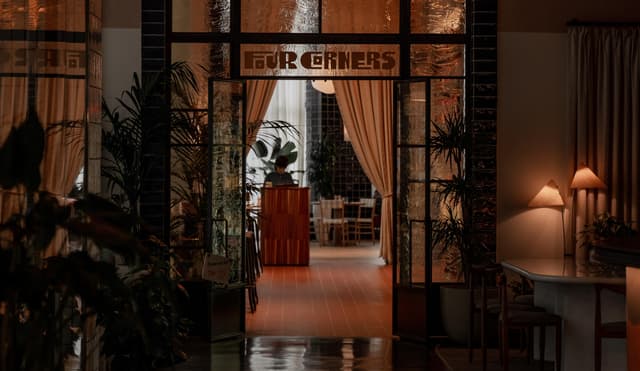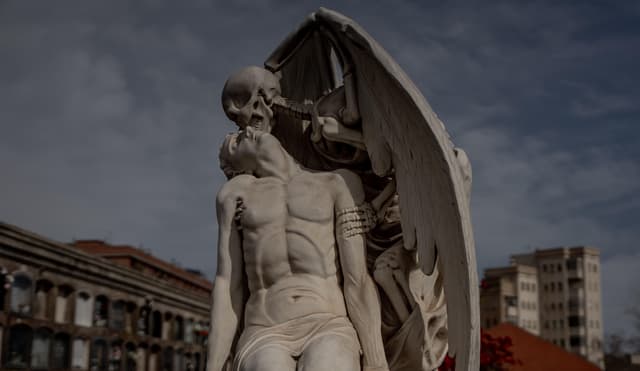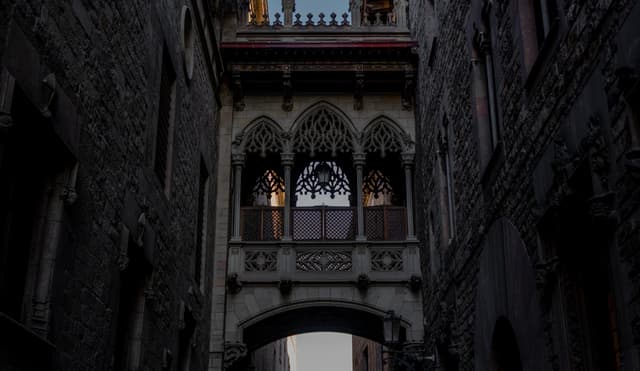The Alternative Guide to Barcelona Map
Save for Later
Share
The Alternative Guide to Barcelona Map
The Alternative Guide
Welcome to The Alternative Guide to Barcelona featuring the 24 best off-beat and unusual things to do. My tailored interactive map is perfect for when you are out on your travels, including my full city guide, photographs and location details all in one place.
Click to discover Barcelona through an alternative lens as we step off the beaten track and unearth hidden gems and curiosities that are often left undiscovered unless you know a local.
Featuring 24 unexpected, gothic and one-of-a-kind locations, I guarantee the guide will make for a memorable yet extraordinary experience to complete your visit to Spain's capital city.
In my interactive map I reveal my black book of favourite places to visit including detailed accounts of each location, historic tales and of course my top travel tips.
This guide was made to inspire you to wander from the usual tourist path, whilst providing a comprehensive guide to inspire fellow off-beat adventurers who intend to visit Barcelona.
Please feel free to get in touch if you have any questions.
Thanks, Vicky
@thealternativeguide_
Updated ago
9
Share
Hotel recommendation

The Hoxton, Poblenou
@thealternativeguide
Set in the culture-rich neighbourhood of El Poblenou, The Hoxton offers the perfect offbeat base when visiting Barcelona. The hotel’s interior design takes inspiration from the vibrant architectural style of the late Spanish architect Ricardo Bofill, incorporating colourful geometric forms whilst using simple local materials such as ceramic tiles, terracotta and concrete.
Upon arrival you will enter through the stylish lobby including a lively café and cocktail bar as well as many cosy corners to relax in. The space is beautifully designed with enormous floor to ceiling windows, hand painted murals and quirky bookshelves, making it so inviting that even the locals like to use it during the day as a co-working hub.
The hotel offers three different types of rooms - the ‘Roomy’, ‘Biggy’ and ‘Homey’ (which is ideal for longer stays). For my solo trip I opted for the ‘Roomy’ or you can also choose a ‘Roomy with a View’ which is slightly more expensive but offers astonishing sights across the city. If you decide to book a stay, my top tip would be to request a quiet room on a high floor as the hotel is located next to a main road, so some of the rooms on the lower levels could be slightly noisy!
Spanning across nine floors, you will find the welcoming bedrooms located off the wavy classic pink corridors. The rooms feature Spanish style interiors using Mediterranean colours, terracotta floors and natural materials in homage to traditional Spanish homes. The inclusion of vintage furniture, touches of floral prints and bespoke tapestries, (which provide a nod to Poblenou’s industrial fabric-making past), achieve an elegantly curated space for your stay. All rooms incorporate a service area including engraved Hoxton mugs, a selection of premium teas and coffees, a Roberts radio and a mini fridge, which were all nice touches and made for an even more enjoyable stay.
Make sure to head up to the rooftop to find the pool, taqueria and bar with glorious views over the sun-drenched city and La Sagrada Familia. A visit during sunset is an absolute must! Alternatively head downstairs to grab a Detroit-style pizza slice from the Four Corners Slice Shop or enjoy taking your time to browse their bodega, stocking a wide selection of local food and beverages.
If you are thinking of booking a stay, please consider supporting the site and using my affiliate link.
Add to
Details
Things to do

The Kiss of Death
@thealternativeguide
In the peaceful cemetery of Poblenou, located in the East of the city, you will find a magnificent marble carving called 'El Petó de la Mort' translating to The Kiss of Death.
The fascinating macabre art piece depicts death as a winged skeleton arching over a young man, extinguishing his life in the form of a gentle kiss. The memorial was created in 1930 to mark the grave of ‘Josep Llaudet Soler’ a young textile manufacturer whose life was taken too soon.
If you look closely you will see a verse chiselled on the base of the tombstone, displaying a poem by Jacinto Verdaguer, a well-known Catalonian poet, which translates to: “His young heart is thus extinguished. The blood in his veins grows cold. And all strength has gone. Faith has been extolled by his fall into the arms of death. Amen”. It is said that Soler’s father took the poem to the workshop of Jaume Barba and requested that the sculpture be a visual representation of this macabre poetic verse.
If you inspect the side of the monument you will see an inscription displaying Jaume Barba’s name, leading you to believe he is the sculptor behind the work, but many attribute the design to Barba's son-in-law Joan Fontbernat.
This thought-provoking piece provides one of the finest examples of memento mori I found whilst visiting Barcelona. It stirs a mixture of emotions upon viewing, but reminds the viewer that death is not something to be feared but instead you should embrace the inevitability of your demise, whilst all the while reflecting on one’s own mortality.
At the bottom of the monument, you will find a small bench where you can sit and admire the masterful technique and attention to detail, which has gone into making this such a touching and celebrated funerary statue.
You will uncover the Kiss of Death tucked away in the Northeast corner of the cemetery surrounded by many other unique and fascinating monuments. It may be the most iconic sculpture to observe, but make sure you allow some time to wander around the rest of this historic cemetery, where you will discover numerous neoclassical mausoleums, gothic chapels and wall upon wall of terraced burial niches.
Add to
Details

Barcelona Cathedral
@thealternativeguide
A gothic masterpiece located in the heart of Barri Gòtic, Barcelona Cathedral dates as far back as the 13th century. The highly decorated structure is built on the former site of a Roman temple, with the construction taking around 150 years to complete.
It’s hard not to stop and admire the majestic architecture from outside every time you pass by. In the 19th century a neo-gothic façade was added showcasing ornate carvings of various saints, kings, prophets and apostles as well as intricate details and mythical decorations, which leave you completely mesmerised. If you want to escape the crowds, the best view I found of the cathedral was from La Casa de l'Ardiaca, which is a 15th-century Renaissance mansion located opposite. Here you can climb up to the first-floor balcony for a wonderful closer look at the looming gargoyles and mythological sculptures.
As you enter the cathedral, stop to admire the neo-gothic archivolt above the church’s front doors, showcasing numerous tiny flying angels, which are carefully positioned to follow the curve of the arch.
Once inside you are instantly surrounded by hundreds of years of history, breath-taking gothic designs and richly coloured stained-glass windows. Its form takes that of a pseudo-basilica, vaulted over five aisles with the outer two divided into chapels. Whilst looking around I found myself completely in awe of its gothic details with its soaring vaulted ceilings, ornate choir stalls and blackened chandeliers, creating the perfect dark and moody atmosphere. It’s incredible to think how most of the church contains works of art and architecture which are now over 600 years old!
Step outside to the Cathedral’s enchanting cloister, which is home to a gaggle of 13 geese. No one is quite sure where the geese originally came from, but you will always find 13 in total, one to represent each of the year’s the Cathedral’s patron saint, Saint Eulalia, lived. You can also find her astonishing sarcophagus in the crypt underneath the high alter.
Whilst outside you can also discover two skull and crossbones carved into one of the paving slabs, which are located on the outer walkway as you turn right upon exiting.
If you have time, make a trip up to the rooftop where you can obtain views across the city and admire more unusual details on this phenomenal gothic gem.
Tip: I would recommend visiting as soon as the cathedral opens in the morning, to enjoy wandering around when it’s not too busy.
Add to
Details

Montjuïc Cemetery
@thealternativeguide
Known as the gateway to Barcelona, Montjuïc Cemetery was inaugurated in 1883 and opened as Barcelona’s main burial ground to accommodate the city’s rapidly increasing population during the 19th and 20th centuries.
The site is located on a steep hillside facing the sea, making it particularly interesting and distinctive in its design. The winding pathways and multiple levels, which span across a 56-hectare site contain over one million burial and cremation ashes in its plots, niches and mausoleums. I spent around three hours here and only saw the lower sections of the cemetery, but if you want to walk all the way to the top, where you can see the crematorium, I would recommend spending most of the day here!
Within the necropolis you are able to discover a wide selection of artistic styles including many gothic, classical, art-nouveau and modernist graves. During the turn of the 19th century Barcelona was home to many rich bourgeoisie families who commissioned their own elaborate vaults, chapels and marble designs to reflect their grandeur and opulent status in death as it was in life. Due to many leading sculptors and architects designing these memorials, the cemetery is filled with some of the most beautiful and astounding funeral art you will experience in the whole of Europe. You will see hundreds of angels, marble carvings and terraced niches, but the two graves which caught my attention the most were that of ‘Dr. Farreras Framis’ and ‘Nicolau Juncosa’.
Dr. Farreras Framis was a professor of anatomy who died in 1888 and his spectacular burial site can be found next to the road near the South entrance. It is instantly recognisable by the cloaked full-length skeleton which lays upon the top of the grave, which was sculpted by the artist Rossend Nobas.
The second grave is that of Nicolau Juncosa, which can be found a few sections up in the middle of the cemetery. Here you will see a shrouded reaper-like figure looming over a seated Juncosa, with its bony skeletal hand resting upon his shoulder. Both graves are wonderful examples of memento mori and can’t be missed when visiting Montjuïc.
Located in the western section of the cemetery you will find one of the most evocative sites, the ‘Fossar de la Pedrera’, also known as the Stone Ditch or Grave of the Quarry. It is estimated that 4,000 people were buried in this mass grave after their execution by General Franco following the fall of Barcelona to his fascist forces during the Spanish Civil War.
Tip: Tie in a visit to the Museum of Funeral Carriages before or after your visit, which is located on the road leading up to the entrance.
Add to
Details

El Pont del Bisbe
@thealternativeguide
Positioned in the hum of the Gothic Quarter, on the narrow street of Carrer del Bisbe, you will stumble upon this striking Neo-Gothic bridge, called Pont Del Bisbe. The ornate structure decorated with arched windows, gothic columns and intricate stone tracery was originally used to connect Casa dels Canonges to Palau de la Generalitat, allowing Catalonian presidents easy passage between the two buildings.
On first glance you would think that the bridge dates back to medieval times but interestingly it was only constructed in 1928 by the architect Joan Rubió i Bellver, who was the official architect of the province of Barcelona in the 1920’s.
Originally a pupil of Gaudí’s, Rubió i Bellver was also involved with projects such as La Sagrada Família and Casa Batlló. Similar to Gaudi, Rubió i Bellver was greatly influenced by medieval gothic design and in the lead up to Barcelona’s International Exposition in 1929, he drew up plans to knock down many of the modern buildings in the Gothic Quarter and to replace them in the Neo-Gothic style. Unfortunately for Rubió i Bellver, the Barcelona City Council didn’t agree with his vision and rejected his plans to construct any other buildings in Barrio Gotic.
This infuriated the architect and to spite the council he added the eerie skull and dagger motif, which can be seen on the underneath of the bridge and is said to curse anyone who gazes upon it. Other myths include the warning that if the dagger is ever removed from the skull the city of Barcelona will fall, however, if you walk backwards whilst staring at the skull it will grant you one wish. Urban legends aside, it’s a great little oddity to look out for when visiting!
Add to
Details

Buy to unlock full guide
Access all the local insights and recommendations from @thealternativeguide when you purchase this guide.
ABOUT THE AUTHOR
The Alternative Guide
Hi there, I'm Vicky founder of The Alternative Guide.
Every time I travel to a new city I make a list of unusual places, quirky stores, speciality coffee shops, dark museums, independent eateries, one-off street art and any other off the beaten track places I can manage to find.
I put www.thealternativeguide.com together to provide an alternative lens on some of the major cities across the world, encourage support for local independents and share my black book of favourite places to visit.
Hopefully this will inspire you to stray from the usual tourist path and at the same time provide a comprehensive guide for fellow off-beat adventurers when travelling to a new city.
Thanks for reading and feel free to reach out to me with any questions.
IG: @thealternativeguide_
What's included
Digital Map
Fully interactive, digital map for finding places nearby
24 places
24 hand-picked places with notes from the creator
DESTINATION(S) COVERED
Barcelona, Spain
FOCUSES AND THEMES
Architecture
Art
Boutique
Adventure
Design
History
People & Culture
Photography
Format
Guide
Guides typically include detailed information and how-to’s about a destination as well as suggested places to try.
COMMON QUESTIONS
What is Thatch?
Thatch is an online marketplace that provides instant access to thousands of vetted local experts and premium travel guides - making it the easiest and most affordable way to take high quality trips with less stress.
For travel creators (tastemakers, travel advisors, influencers and local experts) Thatch makes it easy to curate, publish, and sell digital travel guides, itineraries and personalized planning services.
What if I’m not satisfied with my purchase?
How do I access my purchased guides?
Can I access my guide offline?
How often are guides updated?
Can I request a personalized guide or itinerary?
Can I sell my own travel guides and itineraries?
Save for Later
Share